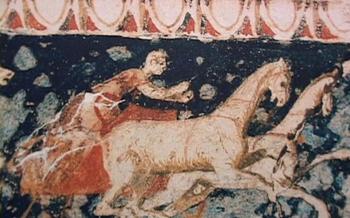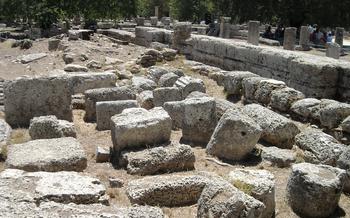
The Ancient City of Eani
- The Antiquity of Eani
- Location and Accessibility
- Exploring the Archaeological Site
- Unveiling the City's History
- Architectural Highlights
- The Temple of Apollo
- The City Walls
- The Agora: The Heart of Ancient Eani
- The Necropolis: Unveiling the City of the Dead
- The Museum of Eani
- Local Festivals and Events
- Accommodation and Dining Options
- Nearby Attractions
- Insider Tip
The Antiquity of Eani
Eani stands as a testament to the rich history and cultural heritage of ancient Macedonia. Archaeological excavations have unearthed a wealth of artifacts, revealing the advanced civilization that once thrived within its walls. These discoveries offer a glimpse into the daily lives and customs of Eani's inhabitants, shedding light on their social structure, religious beliefs, and economic activities.
References to Eani can be found in ancient texts and historical accounts, further solidifying its significance. The city played a crucial role in the region, serving as a center of trade and commerce, and engaging in political and military alliances. Its strategic location at the crossroads of major trade routes contributed to its prominence, facilitating the exchange of goods and ideas between different regions.
Eani's impressive ruins stand as a testament to the skill and artistry of its builders. The well-preserved remains of temples, theaters, and other structures showcase the city's architectural prowess, influenced by a blend of Greek, Macedonian, and Roman styles. These architectural wonders offer a glimpse into the grandeur and sophistication of Eani during its heyday.
Location and Accessibility
Eani's geographical position, nestled within the Kozani regional unit of Greece, offers easy access to major cities like Kozani, approximately 30 kilometers away, and Thessaloniki, the second-largest city in Greece, located about 120 kilometers to the southeast. The journey from Kozani to Eani takes around an hour by car, following the scenic national road that winds through picturesque landscapes. Alternatively, regular bus services connect Kozani and Eani, providing a convenient option for travelers without their own transportation.
Whether you choose to embark on a day trip or plan a longer stay in the area, Eani is easily accessible and well-connected, allowing you to immerse yourself in the ancient history and cultural treasures that await.
Exploring the Archaeological Site
Venture into the heart of Eani and step back in time as you explore the meticulously preserved ruins of this ancient city. The layout of Eani is a testament to its grandeur, with clearly defined city walls, gates, and public buildings. Admire the well-preserved ruins of temples, theaters, and other structures that stand as silent witnesses to the city's glorious past. Ongoing archaeological work at the site continues to unveil new discoveries, offering glimpses into the daily life and culture of Eani's inhabitants. Wander along the designated walking trails, aided by informative signage, and immerse yourself in the history and beauty of this remarkable archaeological site. Conclude your visit with a stop at the on-site museum, where you can peruse artifacts unearthed during excavations and gain a deeper understanding of Eani's rich heritage.
Unveiling the City's History
Eani, as a significant city-state in ancient Macedonia, played a pivotal role in the region's history and development. It was closely linked to the powerful kingdom of Macedon, and its rulers often allied themselves with the Macedonian kings. Eani's strategic location along trade routes made it a prosperous center of commerce and trade. The city's wealth and influence attracted many skilled craftsmen, artists, and intellectuals, contributing to its rich cultural heritage.
Eani's history is marked by several notable events and rulers. In the 4th century BC, the city was conquered by Alexander the Great and became part of his vast empire. After Alexander's death, Eani fell under the rule of the Antigonid dynasty, who continued to develop and embellish the city. During the Roman period, Eani maintained its importance as a regional center and was granted the status of a free city.
Eani's legacy extends beyond its ancient walls. The city's contributions to art, architecture, and philosophy have had a lasting impact on the region's cultural identity. Its ruins continue to attract visitors and scholars alike, providing valuable insights into the lives and achievements of our ancestors.
Architectural Highlights
The architectural heritage of Eani is a testament to the city's advanced civilization and cultural influences. The city's buildings showcase a unique blend of Greek, Macedonian, and Roman architectural styles, creating a distinctive visual aesthetic.
The stone buildings of Eani stand as impressive examples of ancient craftsmanship. Constructed with precision and attention to detail, these structures feature intricate carvings, decorative elements, and well-preserved facades. The temples, in particular, display a refined architectural style, with fluted columns, pediments adorned with sculptures, and finely carved friezes.
Another notable aspect of Eani's architecture is its sophisticated water supply system. The city's inhabitants built an elaborate network of aqueducts, cisterns, and fountains, ensuring a steady supply of water for domestic and public use. This advanced infrastructure highlights the city's commitment to urban planning and public health.
Eani's architecture offers a glimpse into the cultural exchanges and influences that shaped the ancient world. By comparing Eani's buildings with those of other ancient cities in Greece, visitors can appreciate the unique features and contributions of this remarkable city.
The Temple of Apollo
Among the many impressive structures within the ancient city of Eani, the Temple of Apollo stands out as a testament to the city's religious devotion and architectural prowess. Apollo, the Greek god of music, prophecy, and healing, was one of the most revered deities in Eani, and his temple was a central place of worship.
The temple's ruins, which include its foundation, columns, and decorative elements, provide a glimpse into its former grandeur. Built in the 4th century BC, the temple showcased a combination of Greek and Macedonian architectural styles. Its Doric columns and intricate carvings displayed a level of craftsmanship that was unmatched in the region.
The temple's design and orientation were carefully planned to align with the sun's movements. During the summer solstice, the first rays of sunlight would illuminate the statue of Apollo, creating a breathtaking spectacle. This alignment suggests that the temple also served as an astronomical observatory, demonstrating the advanced knowledge and ingenuity of Eani's inhabitants.
Comparisons with other temples dedicated to Apollo in ancient Greece reveal similarities in design and ornamentation. However, Eani's Temple of Apollo possesses unique features that reflect the city's distinct cultural and historical identity. Its strategic location within the city and its association with healing and prophecy made it a sacred and revered site for the people of Eani.
The City Walls
The city walls of Eani, constructed in the 4th century BC, played a crucial role in the city's defense and protection. Comprising massive stone blocks, the walls encircled the entire city, forming an impenetrable barrier against potential invaders. The walls featured multiple gates and towers, strategically positioned for access and security. The main gate, known as the 'Porta Principalis Dextra', was located on the eastern side of the city and served as the main entrance. Smaller gates, such as the 'Porta Principalis Sinistra' and the 'Porta Decumana', provided access from other directions. The towers, positioned at regular intervals along the walls, served as watchtowers and defensive positions, allowing the city's defenders to repel attacks and keep a vigilant watch over the surrounding landscape.
The city walls of Eani stand as a testament to the city's strategic importance and its commitment to security. They are comparable to other ancient city walls in Greece, such as those of Messene and Sparta, which also employed massive stone blocks and sophisticated fortification systems to protect their cities from external threats.
The Agora: The Heart of Ancient Eani
The agora served as the bustling hub of Eani, a place where the city's inhabitants converged for various social and economic activities. Within the agora's confines, the remains of shops and stalls hint at the vibrant commercial life that once unfolded here. Here, merchants displayed their wares, from fresh produce to handcrafted goods, catering to the daily needs of the community.
The agora also played a significant role as a gathering place, where citizens exchanged news, engaged in discussions, and conducted business transactions. Public buildings, such as administrative offices and meeting halls, lined the perimeter of the agora, providing spaces for civic and political affairs.
Excavations at the agora have unearthed intriguing artifacts that provide glimpses into the daily lives of Eani's residents. These discoveries range from coins and pottery fragments to inscriptions and sculptures, each piece contributing to the rich tapestry of the city's history.
A visit to the agora offers a tangible connection to the past, allowing visitors to imagine the hustle and bustle that once filled this central marketplace. It serves as a reminder of the vibrant social and economic interactions that were essential to the functioning of an ancient Greek city-state.
The Necropolis: Unveiling the City of the Dead
The necropolis of Eani, located just outside the city walls, offers a fascinating glimpse into the burial customs and beliefs of its ancient inhabitants. Spread across a vast area, the cemetery contains various types of tombs, from simple graves to elaborate family mausoleums.
Archaeological excavations have revealed a diverse range of burial practices. Some individuals were buried in simple pits, while others were laid to rest in stone-lined cists or vaulted tombs. Wealthier families constructed elaborate chamber tombs with multiple compartments and decorative elements.
The tombs have yielded a wealth of grave goods, including jewelry, pottery, weapons, and tools. These objects provide valuable insights into the social status, wealth, and daily lives of Eani's citizens. Some tombs even contained personal items such as toys, suggesting that the ancient inhabitants believed in an afterlife where they would continue to use their earthly possessions.
The necropolis also sheds light on the religious beliefs of Eani's people. Many tombs feature inscriptions and symbols associated with various deities, such as Zeus, Hades, and Persephone. These inscriptions offer glimpses into the religious practices and beliefs of the ancient Macedonians.
Exploring the necropolis of Eani is a unique and moving experience that allows visitors to connect with the lives and deaths of the city's former inhabitants. It is a place where the past comes alive, providing a glimpse into the rich cultural and spiritual heritage of this ancient city.
The Museum of Eani
Enhancing the immersive experience of Eani's ancient past is the on-site museum, a treasure trove of artifacts unearthed during archaeological excavations. Located within the archaeological site, the museum offers visitors a tangible connection to the city's rich history and cultural heritage.
Exhibits within the museum showcase a diverse array of artifacts, including pottery, coins, tools, jewelry, and sculptures. These objects provide valuable insights into the daily lives, artistic expressions, and religious practices of Eani's inhabitants. Informative panels and displays accompany each exhibit, offering detailed explanations and historical context.
Through its carefully curated collection, the museum sheds light on Eani's significance as a major city-state in ancient Macedonia. Visitors can learn about the city's involvement in trade networks, its political and military history, and its contributions to the broader cultural landscape of the region.
The Museum of Eani is not merely a repository of ancient artifacts; it is a vibrant space that fosters learning, exploration, and a deeper understanding of this remarkable ancient city. Educational programs and activities are regularly organized to engage visitors of all ages, making it an ideal destination for families, history buffs, and anyone seeking to delve into the captivating world of ancient Greece.
Local Festivals and Events
Kozani and the surrounding region are vibrant with local festivals and events that celebrate the area's rich cultural heritage. These events provide an excellent opportunity to experience the authentic spirit of Greece and immerse yourself in its traditions.
One of the most popular festivals is the annual Eani Festival, held in the summer months. This festival showcases Eani's ancient legacy through traditional music, dance, and theatrical performances. Visitors can witness reenactments of ancient rituals and ceremonies, transporting them back in time to the city's glorious past.
Other festivals in the region include the Kozani Carnival, renowned for its colorful parades and lively atmosphere, and the Kozani Wine Festival, where visitors can sample the region's renowned wines and local delicacies.
Attending these festivals is a fantastic way to connect with the local community and gain insights into the customs and traditions of the region. Don't miss the chance to immerse yourself in the vibrant cultural tapestry of Kozani and its surroundings.
Accommodation and Dining Options
When planning your trip to Eani, you'll find a variety of accommodation options to suit your needs and budget. In Kozani, the capital of the regional unit, you'll find a range of hotels, from budget-friendly options to luxurious resorts. For a more authentic experience, consider staying in one of the traditional guesthouses or bed and breakfasts in the nearby villages.
For dining, Kozani offers a diverse culinary scene, with restaurants serving everything from traditional Greek dishes to international cuisine. Be sure to try local specialties such as "giaprakia" (stuffed vine leaves), "moschopouggo" (lamb stew), and "tsipouro" (a local spirit). For a truly unique experience, head to one of the traditional tavernas in the villages, where you can enjoy homemade dishes and soak up the local atmosphere.
Here are some tips for finding affordable and authentic dining experiences:
- Look for tavernas and restaurants that are frequented by locals. This is usually a good indication of quality and value.
- Don't be afraid to ask for recommendations from your hotel or guesthouse. They can often point you in the right direction for good food and reasonable prices.
- Take advantage of the daily specials offered by many restaurants. These can be a great way to save money and try new dishes.
- Don't forget to try the local wine, which is produced in the Kozani region. It's a delicious and affordable way to experience the local culture.
Nearby Attractions
Beyond the ancient city of Eani, the Kozani region offers a wealth of other historical sites and natural attractions. Embark on a day trip to the picturesque Lake Polyfytos, nestled amidst stunning mountain scenery. Explore the traditional villages of Tsotyli and Nymfaio, where cobblestone streets, charming houses, and local crafts await. Discover the Byzantine monasteries of Agios Nikolaos and Panagia Soumela, which boast intricate frescoes and a rich history. Nature enthusiasts can hike through the verdant forests of the Pindus Mountains, encountering cascading waterfalls, lush vegetation, and breathtaking views. Create an itinerary that combines multiple destinations, allowing you to delve deeper into the region's diverse offerings. With its rich tapestry of history, culture, and natural beauty, the Kozani region promises an unforgettable adventure for every traveler.
Insider Tip
Beyond the well-trodden paths of Eani's archaeological site, there lie hidden gems waiting to be discovered. As you wander through the ancient ruins, keep an eye out for secluded corners and vantage points that offer breathtaking panoramas. The hilltop of the acropolis provides a sweeping vista of the surrounding landscape, with the distant mountains forming a majestic backdrop to the ancient city. For a unique photo opportunity, venture off the beaten track and explore the lesser-known parts of the site, where crumbling walls and overgrown paths create an air of mystery and intrigue.
Remember to respect local customs and traditions during your visit. When visiting religious sites, such as churches or monasteries, dress modestly and behave respectfully. Engage with the locals in a friendly and open manner, and don't be afraid to ask for directions or recommendations. They will be delighted to share their knowledge and help you make the most of your time in Eani.
To truly immerse yourself in the local culture, take the opportunity to sample the regional cuisine. Kozani is renowned for its delicious dishes, such as the spicy sausage known as "loukaniko" and the traditional bean soup called "fasolada." Don't miss the chance to indulge in these culinary delights and savor the flavors of Eani's rich heritage.
With its captivating history, stunning scenery, and warm hospitality, Eani offers an unforgettable experience for travelers seeking to explore the depths of ancient Greece. Embrace the spirit of discovery, wander off the beaten path, and uncover the hidden treasures that await you in this extraordinary destination.




